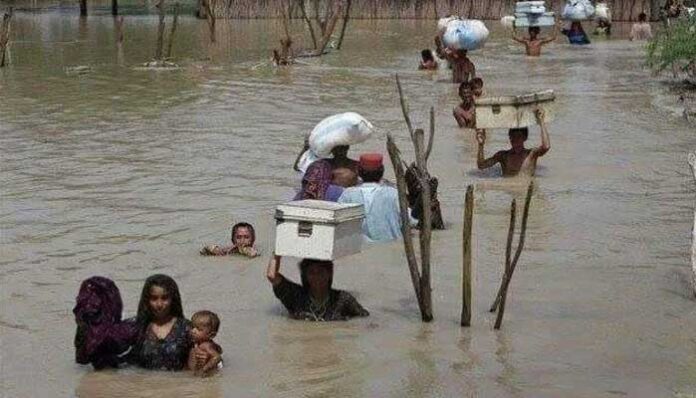Grocery shopping in Pakistan is one of the most daunting household chores. Scuttling through crowded bazaars with clumsy baskets filled with a motley of rations– the whole experience is taxing. This repugnant feeling compounds if you’re dragged to the market on a Sunday afternoon! Yet this feeling is nothing compared to the feeling of absurdity when you stare at the receipt with staggering prices and a stratospheric total that completely diminishes your expected monthly budget. To me and myriad other young professionals, this moment is a crude awakening to the throes of inflation currently ensnaring the emerging economies around the globe.
According to the Pakistan Bureau of Statistics (PBS), Pakistan’s federal agency to provide comprehensive national statistical services. headline (monthly) inflation peaked at 27.3 percent in August – a historic high of 47 years. The absolute downward spiral could be gauged by the severity of the gap of actual inflation to the government’s inflation target for this fiscal year – 11.5 percent. People talk about numbers and trends, historical statistics, and draw comparisons to somehow paint a proverbial rainbow amidst the overarching dark clouds. Frankly, I’m not going to do that!
Just to give you an idea of the acuteness of economic misery, take in that prices of onions have doubled since last year; pulses are almost 90 percent more expensive in rural areas than the previous year, and cooking oil is comparatively up by circa 83 percent. These commodities are not even avoidable in an average household. And the prices would only continue to rise going forward given that almost 40 percent of our standing crops have been washed away. Imagine the pain of a lower-income family in such dire straits.
The devastating floods in Pakistan are the front-running visuals championed by climatic critics across the world. Even our politicians are scrambling from conference to conference, country to country, to gain some financial respite. Even when pressing our case, their tone is subtly regressing from rhetoric to groveling for help. To be clear— we are not a charity case! The destruction caused is not entirely of our making. True, we are perilously leveraged as a developing nation. And true that we do not have our act together as a responsible government or even a democracy. But this catastrophe has a lot to do with the storm brewing abroad.
The floods in Pakistan have killed over 1700 people. Upended villages and colonies. Razed entire towns and districts. And according to a recent report by the World Bank, the rate of poverty in Pakistan has surged from 2.5 percent to 4 percent, plunging between 5.8 million to 9 million people into poverty, due to the cataclysmic effects of floods on livestock, rural employment, harvests, and education.
Over 20 percent of the 220 million population of Pakistan is below the poverty line, according to Asian Development Bank (ADB), when Pakistan contributes less than 1 percent of the global emissions responsible for climate change. In contrast, China contributes roughly 27 percent of global emissions, while the USA’s account for 11 percent. However, Pakistan still owes roughly half of its external debt to China with no prospect of a waiver despite a recent loan rollover. Admittedly, China has committed roughly $91 million in humanitarian assistance to Pakistan; the US has donated about $67 million in flood relief to supposedly offset the loss— iniiallly estimated at $30 billion.
Therefore, while I was taken aback at the grocery store last week, I think the inflationary signs would only worsen in visibility from this point onwards. And if the world doesn’t wake up to somehow avert this brewing economic crisis in the developing world, no amount of monetary tightening or fiscal prudence can forestall a global financial meltdown. And the effects of economic flooding would surely not be restricted to Pakistan!
Pakistan doesn’t want alms but rightful assistance to counteract the mess they have created. Yet any altruistic consideration or remorse should not be expected from any of the advanced economies. Even the puny contributions by the global power duo were not without the traditional game of ‘blame thy enemy’ as the US Secretary of State Antony Blinken took a convenient dig at China to restructure Pakistan’s debt, while China resorted to highlighting its assistance as a friendly favour as opposed to a moral responsibility.
Unfortunately, the story doesn’t end with floods, which some could still blame nature for and move on. The war in Ukraine has exacerbated the energy costs for countries like Pakistan, heavily dependent on imported fuel. Yet what the policymakers in the West fail to mention is the effect of their monetary tightening on developing countries. It is like a repeat of the late 1990s when the dollar’s burgeoning strength heralded the downfall of currencies in emerging markets.
Today, with the US dollar pounding the yen, renminbi, pound, and rupee, the Federal Reserve has pushed the developing economies into a corner with virtually a single choice: match its hawkish rate hikes to avoid a significant drop in domestic currency valuation. However, with the floods already slowing the economy, rate hikes would kill the economic growth of Pakistan, already foreshadowed to lower to 2 percent by the World Bank. Thus, the State Bank of Pakistan maintained its policy rate at 15 percent this month, the highest in the region, after raising rates cumulatively by 800 basis points from September 2021 through July.
However, the forward guidance by the Fed presages that it would hike the interest rate by at least another 100 basis points before year-end. That would push the short-term interest rates more than a percentage point above the rate of neutrality of 4-4.5 percent, which would be devastating for import-dependent and investment-starved countries like Pakistan.
It’s hard to miss the parallels with Sri Lanka. The notorious default on $51 billion external debt still wrings the Sri Lankan economy. The litmus test of Pakistan’s creditworthiness, its international bonds, are trading at half the issued value, a chief indicator of sinking investor confidence. Unsurprisingly, Moody’s credit rating agency relegated Pakistan’s rating to Caa1, earmarking its debt as “Highly risky” while maintaining a negative outlook on Pakistan. In an accompanying statement, the rating agency highlighted that “debt affordability and a long-standing credit weakness for Pakistan, will remain extremely weak for the foreseeable future.” Pakistan’s total debt accounts for over 70 percent of its GDP, with almost half the government revenue budgeted for debt servicing in the ongoing fiscal year. Now as the tax revenue gradually seeps due to an inevitable slowdown in economic activity, the strengthening dollar would further burden the national exchequer to pay burgeoning interest on foreign debt since the US currency stands as the de facto fulcrum of the global financial system.
Pakistan’s foreign exchange reserves have resultantly dwindled below $8 billion— barely enough for 3 weeks’ imports— despite receiving the $1.17 billion IMF tranche. Raising additional debt to patch the budget deficit would inflict further damage since interest rates are prohibitively high in both international and domestic bond markets. About a quarter of Pakistan’s import bill is tied to crude and petroleum products. While \energy prices have lowered in recent months, the bustling dollar has effaced the gains. The twin fiscal and trade deficits would not only constrict Pakistan’s recovery from the floods; it would also damage its social fabric beyond that already inflicted by the pandemic. Thus, Pakistan– like Sri Lanka– faces economic turmoil on all fronts, further fomented by the actions of the Federal Reserve.
So not only are we barreling towards a chaotic recession piecemeal but we are almost guaranteed to import more inflation while at the cusp of a default. And while our newly appointed finance minister — ironically an absconder in corruption cases— claims that Pakistan would seek to reschedule bilateral loans, standing at around $27 billion, while paying commercial and Paris Club creditors sans pursuing haircuts, I don’t see any viable option to fully salvage our economy.
With the recent production cut announced by the OPEC Plus (Saudi-led OPEC + 10 exporters headed by Russia)- and no let-up in the Russo-Ukrainian conflict, Pakistan would likely feel no interlude in elevated import prices while exports and remittances would likely plummet, in line with the loss of agricultural output to floods and the recessionary headwinds gaining traction worldwide.
If not for the attractive returns on US treasuries, the political uncertainty in Pakistan would surely keep investments at bay in the foreseeable future. And while multilateral and bilateral donors could prove to be the mainstay of Pakistan’s financial survival, as recent history dictates, I don’t anticipate any breathing space to the economy. Given the country required upward of $34 billion in the ongoing fiscal year – excluding newfangled requirements for normalizing the current account deficit, stable foreign exchange reserves, and the exigent restructuring costs of flood-wrecked localities – Pakistan would likely starve for hard currency until stability returns to the global commodity and debt markets.
Therefore, while I was taken aback at the grocery store last week, I think the inflationary signs would only worsen in visibility from this point onwards. And if the world doesn’t wake up to somehow avert this brewing economic crisis in the developing world, no amount of monetary tightening or fiscal prudence can forestall a global financial meltdown. And the effects of economic flooding would surely not be restricted to Pakistan!






















